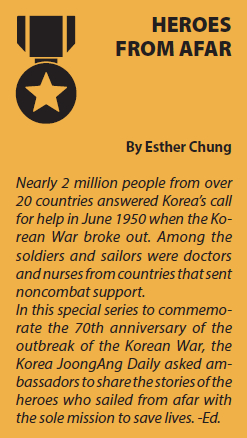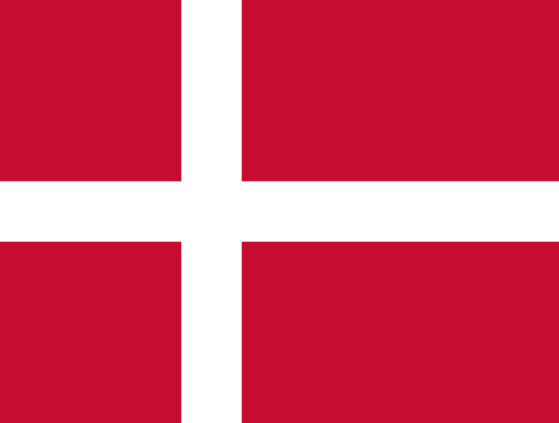[Heroes from afar] Denmark's medics, hospital ship saved countless lives
![Ambassador of Denmark to Korea, Einar Hebogard Jensen, speaks to the Korea JoongAng Daily at the embassy on Sept. 28. [PARK SANG-MOON]](https://koreajoongangdaily.joins.com/data/photo/2020/10/25/12d1f241-2e7b-4fc8-8e18-399fd1ad2cb5.jpg)
Ambassador of Denmark to Korea, Einar Hebogard Jensen, speaks to the Korea JoongAng Daily at the embassy on Sept. 28. [PARK SANG-MOON]

“It was March 15, 1953, when I had a terrible accident at a railway in Incheon,” Kim told the Korea JoongAng Daily on Oct. 21. “When I came to [my senses], I saw that my left leg was gone.”
Kim was just 14 at the time. His family, based in Pyongyang, had split at the start of the Korean War (1950-1953), with Kim and his father making their way south. They couldn’t take Kim’s younger sister and grandmother as they didn’t know what the journey south on foot might entail. His mother had died when he was eight.
Kim and his father had settled near Incheon as the war raged. Kim worked as a newspaper delivery boy. He used to hop onto passing trains to try to cover all his customers for the day, some of whom were too far to cover by foot. The gambit backfired terribly on that day in March 1953.
Kim recalled lying there for what seemed like forever. No one was willing to help. His father found him eventually and rushed him to a hospital.
“They said I had lost so much blood by then and needed a blood transfusion, but my father was in such a poor state of nutrition that he couldn’t help me,” Kim said. “That’s when a Danish medic stepped forward. His name was Johan Petersen Frisk.”
Frisk was a nurse on board the Jutlandia, a hospital ship with nearly 400 beds and around 100 medical staff. Sent to Korea in January 1951, it moored in Busan until it was moved to Incheon Port in November 1952.
Kim survived with a transfusion arranged by Frisk — using his own blood.
![Kim Ju-whan in September 1953 on the day he was discharged from Jutlandia in this photo taken by a Danish nurse on board, Tove Jagd. [DANISH JUTLANDIA VETERANS]](https://koreajoongangdaily.joins.com/data/photo/2020/10/25/0989aac4-9722-4339-98e5-f8071eef4830.jpg)
Kim Ju-whan in September 1953 on the day he was discharged from Jutlandia in this photo taken by a Danish nurse on board, Tove Jagd. [DANISH JUTLANDIA VETERANS]
“It was sheer hell to try to live in Korea during the war,” Kim said. “Everything that your eyes could behold was in ruins. Jutlandia helped me hope again. I made up my mind then that when I grow up, I am going to go to Denmark and thank everyone I meet.”
Back in Denmark at the time, there were at least 3,000 others who volunteered to be in Frisk’s place, according to the Danish Embassy in Korea.
“It is said that about 3,000 to 4,000 nurses volunteered to serve aboard the Jutlandia and interviews had to be conducted, which goes to show the extent of the support the hospital ship received from the people,” said Einar Hebogard Jensen, ambassador of Denmark to Korea, in an interview at the embassy. “The memories of war and human suffering meant that the Danish population was very quick to support the political proposal to send a hospital ship to aid the Republic of Korea and the United Nations Command.”
The news of the outbreak of the Korean War reached Denmark within five years of its own experiences of warfare. The country declared itself neutral at the start of World War II but was occupied by Germany for most of the war.
“After national discussions on how to contribute to the mission, Denmark decided to contribute to the UN Command with the hospital ship MS Jutlandia,” Jensen said.
The Jutlandia, which was a passenger and cargo vessel refitted as a hospital ship, was equipped with four surgery facilities, four hospital departments with a total of 356 beds for patients, X-ray facilities, an eye clinic, dental clinic, pharmacy and laboratories, according to the embassy. It had a helicopter pad so that wounded soldiers could be flown onto the ship directly from the battlefield.
![A wounded soldier being transported onto Jutlandia from a helicopter. [DANISH JUTLANDIA VETERANS]](https://koreajoongangdaily.joins.com/data/photo/2020/10/25/da921585-a882-42a1-8817-cc9f6dd750c9.jpg)
A wounded soldier being transported onto Jutlandia from a helicopter. [DANISH JUTLANDIA VETERANS]
It treated 4,981 wounded soldiers during its 999 days of service in Korea until Aug. 16, 1953, according to the Korean Ministry of Patriots and Veterans Affairs.
Although the vessel’s main mission was to treat soldiers wounded in the war, the hospital made its services available to civilians at the request of the Danish crew on board.
“The most famous civilian patient was the President, Syngman Rhee, who received dental treatment aboard the ship,” Jensen said. “While records are unclear, it is estimated that around 6,000 civilians — or even three times that number — were treated. There are records of only 29 civilians losing their lives, which I must say is impressive. The hospital ship and its crew did a great job.”
The Jutlandia traveled between Denmark and Korea three times throughout the war to replenish its supplies and rotate doctors and nurses. A total of 630 Danes served on these missions, according to records at the Korean Ministry of National Defense.
![Danish nurses on board the Jutlandia with young Korean civilians who received medical treatment on the vessel. [DANISH JUTLANDIA VETERANS]](https://koreajoongangdaily.joins.com/data/photo/2020/10/25/62afafff-e2ee-426d-b921-bb2da8793d91.jpg)
Danish nurses on board the Jutlandia with young Korean civilians who received medical treatment on the vessel. [DANISH JUTLANDIA VETERANS]
![A medical operation on the Jutlandia, which treated nearly 5,000 soldiers and at least 6,000 civilians during the Korean War. [DANISH JUTLANDIA VETERANS]](https://koreajoongangdaily.joins.com/data/photo/2020/10/25/a4ff598b-328a-462a-ab90-cedd4794e910.jpg)
A medical operation on the Jutlandia, which treated nearly 5,000 soldiers and at least 6,000 civilians during the Korean War. [DANISH JUTLANDIA VETERANS]
On board the Jutlandia on its third and final mission included 29-year-old engineer Svend Jagd and 28-year-old nurse Tove Lodbjerg. By 1955, Lodbjerg had adopted a new name.
“My parents met on the ship, and after returning to Denmark in 1953, they were married approximately one and a half years later, in January 1955,” Henrik Jagd told the Korea JoongAng Daily on Sept. 10, in a written response to a set of questions. “[It was] one of several marriages among the crew and hospital staff, [and] my father has always commented that all the marriages lasted, primarily because the people had met under such strenuous conditions, that they had seen the worst.”
![Tove and Svend Jagd during their medical mission to Korea on Jutlandia during the Korean War (1950-1953). [DANISH JUTLANDIA VETERANS]](https://koreajoongangdaily.joins.com/data/photo/2020/10/25/118d9520-5e87-444c-a54c-9708b6d6dc5d.jpg)
Tove and Svend Jagd during their medical mission to Korea on Jutlandia during the Korean War (1950-1953). [DANISH JUTLANDIA VETERANS]
“Many scenes stand out in the stories of my parents," Jagd wrote. "The most immediate was the total destruction of Seoul that they were met by upon arrival, a contrast [with] Seoul today."
After leaving in 1953, his parents returned to Korea decades later.
“When they were there for the first time — in 1983 I believe — they were walking the streets of Seoul,” Jagd said. “They wanted to cross a street, and a local traffic police man offered to help, and when he saw they were veterans from Jutlandia he stopped all traffic in the intersection so my parents could cross — such was the respect they were met with.”
![Svend and Tove Jagd. [HENRIK JAGD]](https://koreajoongangdaily.joins.com/data/photo/2020/10/25/68df477d-bb25-406e-9f70-3afe8ad51a3d.jpg)
Svend and Tove Jagd. [HENRIK JAGD]
“He has always commented on the enormous gratitude he has felt issuing from Korea towards the veterans of the Jutlandia, and how impressed he is on what the South Koreans have done with the freedom so hard won during the war,” Jagd said.
Long-awaited reunions took place both in Korea and Denmark.
“It was April 29, 1994, when I was finally able to meet with Frisk again in Denmark,” Kim said. “During that visit, I was also able to meet with Tove Jagd and her husband Svend Jagd. It felt so good to be together again.”
![From left, Tove Jagd, Kim’s wife, Johan Petersen Frisk, Kim and Svend Jagd, at a reunion in Denmark in April 1994. [DANISH JUTLANDIA VETERANS]](https://koreajoongangdaily.joins.com/data/photo/2020/10/25/c51c26c2-cb10-49f1-92ce-7b10080cbc6d.jpg)
From left, Tove Jagd, Kim’s wife, Johan Petersen Frisk, Kim and Svend Jagd, at a reunion in Denmark in April 1994. [DANISH JUTLANDIA VETERANS]
“I went back to see him hospitalized, and again to send him off,” Kim said.
Kim called Frisk his "papa-san" from the time he was on board the Jutlandia. Papa-san was picked up by Koreans during the Japanese occupation of Korea, and was used as a term to address a man older than oneself.
"Especially my mother […] remembered Kim from Jutlandia personally," Jagd said. "At a reunion [of the three], Kim declared that now that Johan Frisk had died, he would look upon my parents as his Papa- and Mama-san. Kim still refers to my father as his Papa-san in emails to him."
There were just 16 Danish veterans of the Korean War alive as of 2015, according to the Korean Embassy in Denmark.
Every year, commemorations are held in their memory at monuments in Korea and Denmark.
“In Denmark, the Danish Association of Veterans honors the Jutlandia veterans every year on Oct. 16 at the memorial plaque at Langelinie promenade — the day that Jutlandia arrived back in Copenhagen for good,” Jensen said. “The plaque depicts an image of Jutlandia and a description of its service.”
![A space at the Korean Embassy in Denmark dedicated to memories on board the Jutlandia. [DANISH JUTLANDIA VETERANS]](https://koreajoongangdaily.joins.com/data/photo/2020/10/25/e64949bf-e97e-4842-be86-ddafbded8b8f.jpg)
A space at the Korean Embassy in Denmark dedicated to memories on board the Jutlandia. [DANISH JUTLANDIA VETERANS]
In Korea, a monument dedicated to the Danish veterans stands at the War Memorial of Korea in central Seoul.
![Monument dedicated to Danish veterans of the war, at the War Memorial of Korea in central Seoul. [EMBASSY OF DENMARK IN KOREA]](https://koreajoongangdaily.joins.com/data/photo/2020/10/25/45905a74-e0f3-4fcc-8d8c-ef4a9dfc5786.jpg)
Monument dedicated to Danish veterans of the war, at the War Memorial of Korea in central Seoul. [EMBASSY OF DENMARK IN KOREA]
“When MS Jutlandia sailed back to Denmark on Aug. 16, 1953, 13 doctors, nurses and other health care workers decided to stay behind to help the local people,” Jensen said. “A few years later, in 1958, they established a medical center that became the basis for what we know today as the National Medical Center in Seoul. I am proud that Danes contributed to the establishment of this center.”
Even for the young Danes born long after the Korean War, the Danish mission during the war has been immortalized through a hit song by Kim Larsen in 1986. The reprise in “Jutlandia,” translated, goes like this:
“Hey-ho for Jutlandia
She comes as called to the battle
At home, the hunter has returned home from hunting
And the sailor returned home from the sea.”
![Jutlandia. [HENRIK JAGD]](https://koreajoongangdaily.joins.com/data/photo/2020/10/25/290021d7-9f65-45e9-bc3a-e5d2cf5154cc.jpg)
Jutlandia. [HENRIK JAGD]

Denmark was one of six countries that sent medical support during the Korean War (1950-1953) and the only country apart from the United States to send a hospital ship. The Jutlandia, a 8,500-ton passenger and cargo ship, was refitted into a hospital vessel with a total of 356 beds for patients, X-ray facilities, an eye clinic, a dental clinic and a pharmacy, as well as a helicopter pad.
The ship arrived in Korea on March 7, 1951, and treated 4,981 wounded soldiers until its final departure on Aug. 16, 1953. It also treated civilians, both on the ship and in first-aid shelters on land, and as many as 6,000 to 18,000 civilians are said to have been treated by 630 Danish medical crew.
After the Jutlandia’s departure, 13 Danish medical staff members stayed behind to continue to offer their medical services. They contributed to the foundation of today’s National Medical Center in Seoul.
This series is a weekly publication in cooperation with the 70th Anniversary of the Korean War Commemoration Committee.











with the Korea JoongAng Daily
To write comments, please log in to one of the accounts.
Standards Board Policy (0/250자)